All about wood-fired samovars
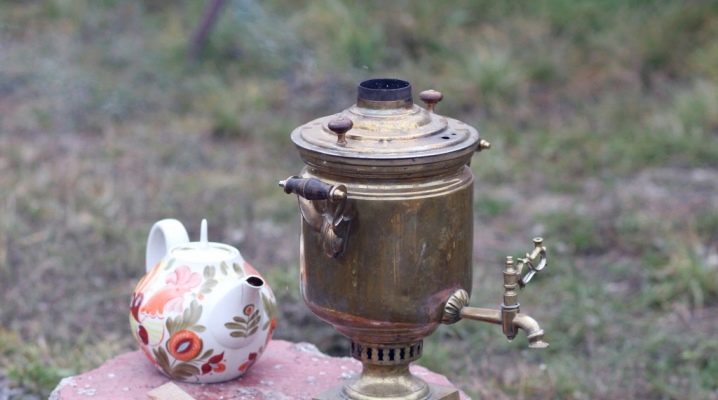
Connoisseurs of Russian culture put the samovar on a par with the balalaika and matryoshka. However, if you ask a modern person to brew tea in it, he will find himself in a serious difficulty. That is why we decided to dwell in more detail on the features of the firebox and brewing tea in a wood-fired samovar.
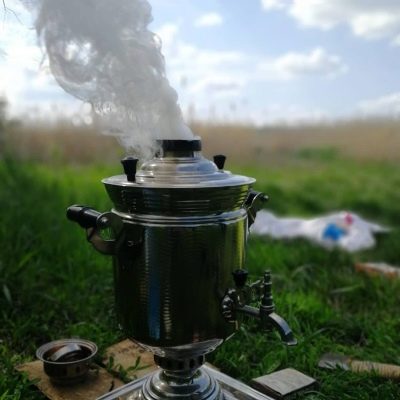
Device
There is no exact information about the place where wood-fired samovars appeared, so it is not possible to say for sure where it was created. There is a version that it appeared in China - and in fact, there are similar devices there. They are called "ho-go", where the Chinese serve first courses.
According to another legend, the samovar was invented in Europe, and Peter I brought it to Russia. According to the third theory, the wood-fired samovar is a primordially Russian invention and was invented by the Ural blacksmith Demidov.
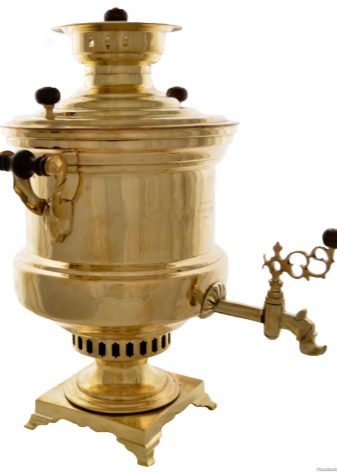

It is only known for certain that in 1778 in Tula the production of devices for heating water was first mastered. The enterprise was opened by the Lisitsyn brothers. This fact is confirmed by historical documents, they became the reason for the widespread opinion that the homeland of the samovar is Tula. However, this does not correspond to reality, since the mention of this product is found in the list of Demidov's property dated 1740.
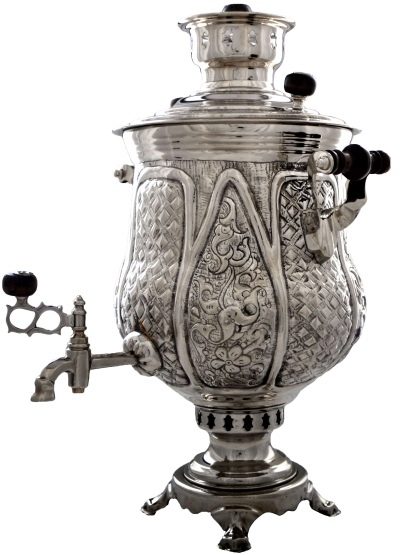
One way or another, but in Russia the samovar has received the widest distribution. In the middle of the 19th century, about 3 dozen samovar factories were opened on the territory of the country. Love for this original device has come down to our times - samovars are often bought by the owners of summer cottages and country houses.
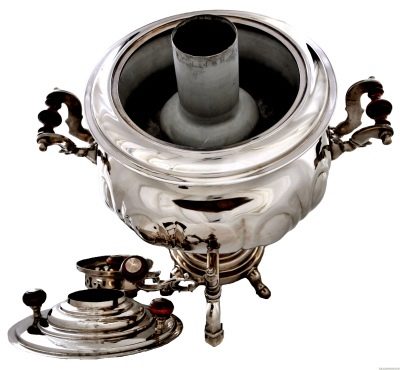
The design of a wood-fired samovar includes several basic elements.
- Inside there is a jug-like tube in the form of a brazier, fuel is put into it. A blower is located under the bottom of this jug, a rim and a lid are fixed on top.
- On the lid there are contractors for removing steam.
- From the inside, the product is equipped with legs, a cap is provided on top, on which you can put a teapot with tea leaves.
- Any samovar must have a drain tap - it can look like a key or take on other intricate forms.
- The main block is represented by a wall - water is poured into it.
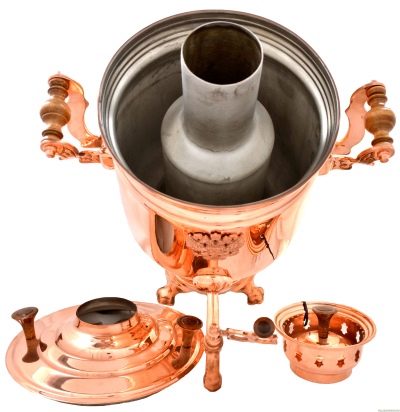
The design of a wood-fired samovar is thought out in such a way that all the heat released during combustion by wood is directed to heating water.
Therefore, it boils quickly enough and retains its temperature for a long time.
Advantages and disadvantages
The advantage of any samovar is that this device not only boils water, but also softens it. That is why tea from a samovar turns out to be much tastier than from a teapot. And there are two explanations for this.
- The water in the samovar boils a little slower than in a traditional electric kettle. As a result, its structure fully retains its useful properties and is not destroyed.
- A well-known fact: regardless of the container in which water is boiled, scale will appear on the walls and bottom sooner or later. At the same time, in order to pour water into a cup from a teapot, you have to turn it over, the water is loosened and part of the scale is in it. It is not good for the body. In a samovar, such adverse effects are excluded, all salts remain on the bottom and walls.
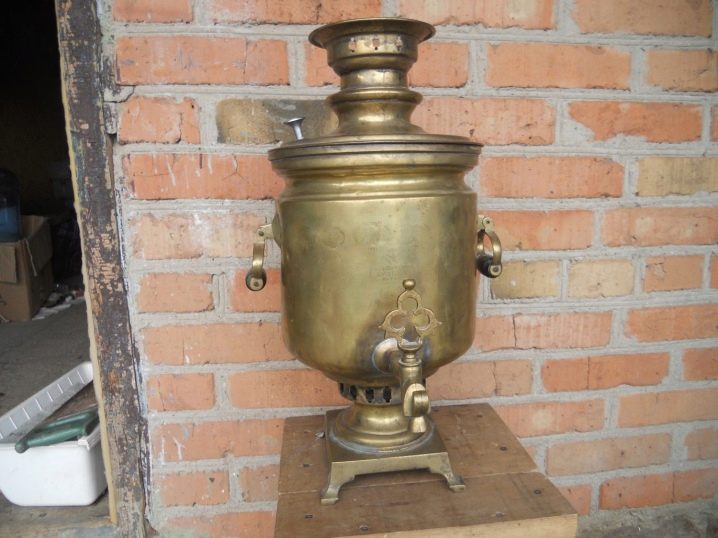
That is why the samovar is so loved by supporters of a healthy lifestyle and proper nutrition.
If we talk about productivity, the wood-fired samovar is significantly inferior to the coal one.The problem is that during the combustion of coal, a significant amount of pure carbon is released, this determines the course of combustion in the lower block of the structure. As a result, the liquid warms up very quickly and begins to rise upward, while cold water, on the contrary, goes downward.
The principle of operation of wood-burning products is slightly different. When burning, the wood decomposes into carbon and hydrogen, such combustion is carried out in the upper block of the vessel. In this case, the water heats up very slowly.

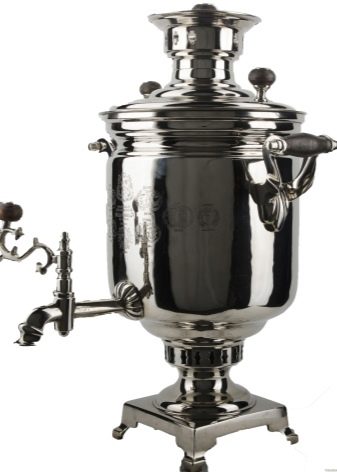
The disadvantages of samovars also include high cost and low availability. Nowadays, such devices can be purchased exclusively from hands or in antique stores. Alternatively, you can make an online order, but in this case, a long wait for delivery is inevitable.
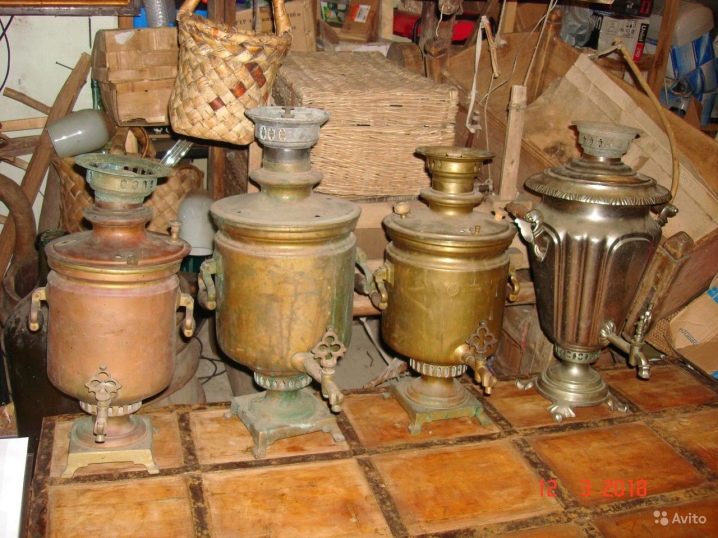
Views
The wood-fired samovar is presented in a wide variety of forms, each of them has its own operational features.
- Jar - these samovars were in demand at the beginning of the XIX-XX centuries. In appearance, they look like the most ordinary can, such devices were often found in taverns and on trading stalls.
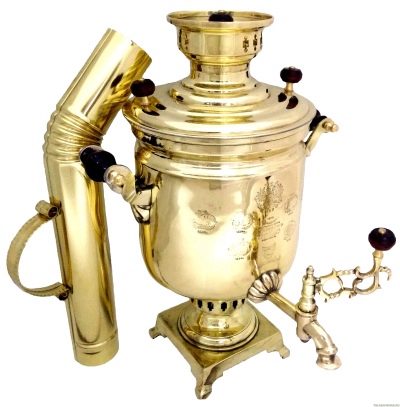
- Glass - one of the most common options. The products were distinguished by their affordable price and durability. Today they are often found in museums and private collections.
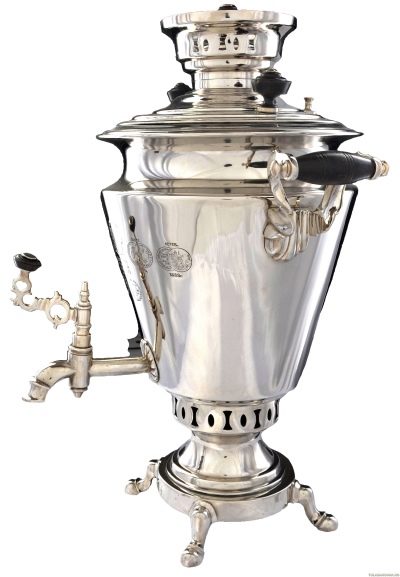
- Ball - as the name suggests, such devices were spherical. Especially impressive were such models of immigrants from the East, who have always been famous for their love of such forms when arranging interiors. It is no coincidence that such products were sent in large quantities to Turkey and Persia.
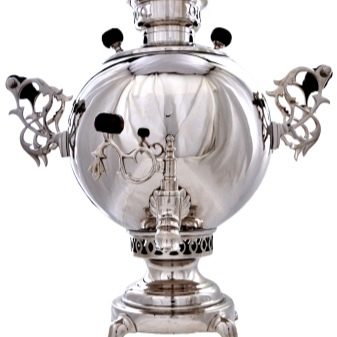

- Egg - these samovars were produced in two versions: an ordinary egg - in this case, the narrowing is noticeably closer to the bottom, and Easter - the narrowing is located on top.
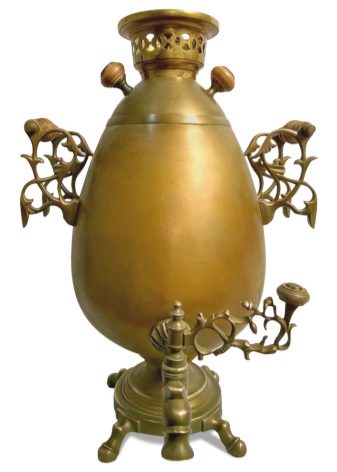
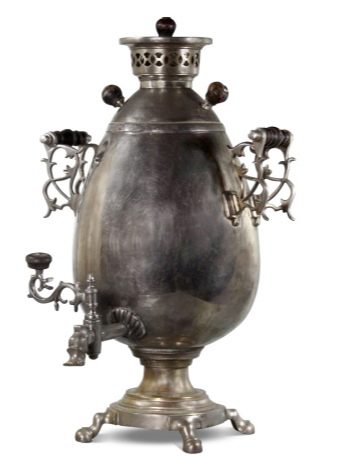
- Vase - such products were decorated with columns, medallions, patterns, embossings and other decorative elements. In the 19th century, such utensils adorned the houses of representatives of the large bourgeoisie and nobility.

Wood-burning samovars also differ in the materials of manufacture.
- Copper - the most common option. Copper is a refractory and ductile material with increased thermal conductivity. It is well polished, engraved, minted and forged well. Such samovars were often painted.
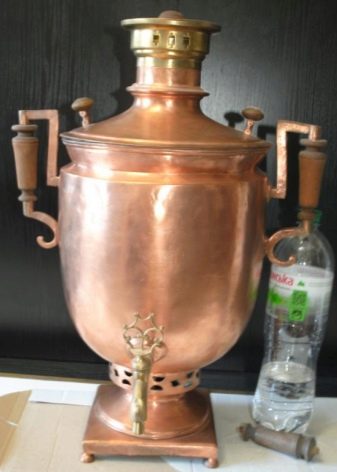
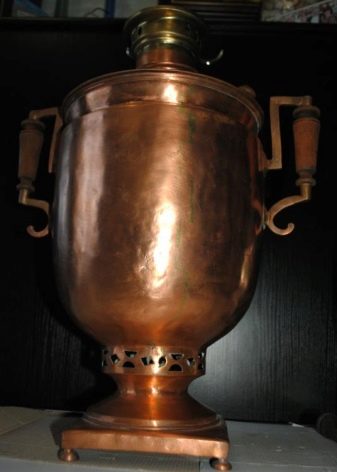
- Brass - copper samovars have always been expensive, so to reduce the cost, they began to be produced from brass. The presence of copper in this alloy is approximately 55-60%. Such products are harder and more practical than copper ones, while being much cheaper.
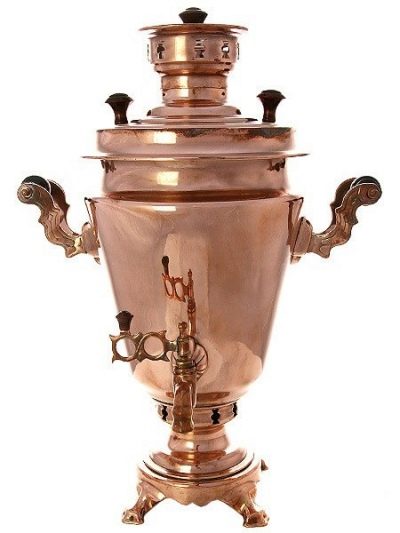
- Tompak - samovars made of tombak were very popular. This metal is also called "yellow copper" or "fake gold". It contains tin, zinc and lead. Visually, it resembles gold, but the operating parameters are as close as possible to copper. Such samovars were purchased only by the richest and wealthiest people.

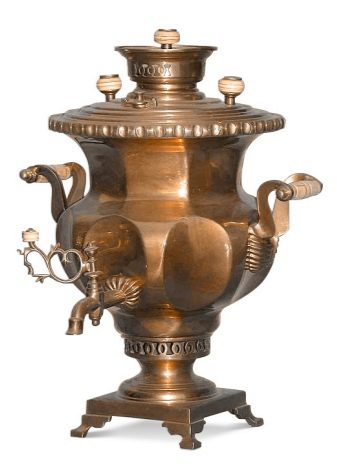
- Cupronickel - are represented by alloys based on copper, zinc and nickel. This metal has a silvery hue, so samovars often imitated silver ones.
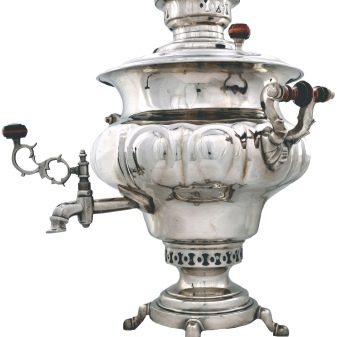
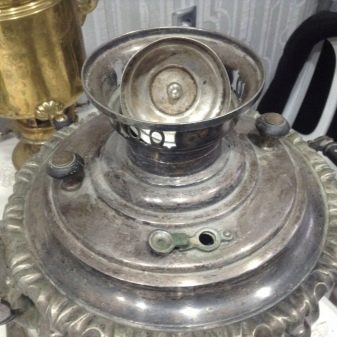
Slightly less often, Tula steel and cast iron were used in samovar craft; gilded bronze models are also rare.
Top manufacturers
Antique samovars are in the greatest demand. In the entire history of this craft, only a few manufacturers have succeeded to receive the title of "samovar kings" - these are the Batashevs, Shemarins and Lomovs.
Samovars of the Batashevs were in the highest demand; today they can be found in private and museum collections. Among them there are even products made specifically for members of the royal family. Shemarins are famous artisans who come from serfs. The samovar business was opened by five brothers, and by the beginning of the twentieth century their factory was producing over a hundred models.

Over time, they have a lot of equally worthy competitors. Samovars Teile, Chernikov, Vorontsov, Kopyrzin have always been distinguished by their high quality. Malikovs, Vanykins and Puchkovs were considered active participants in samovar production.

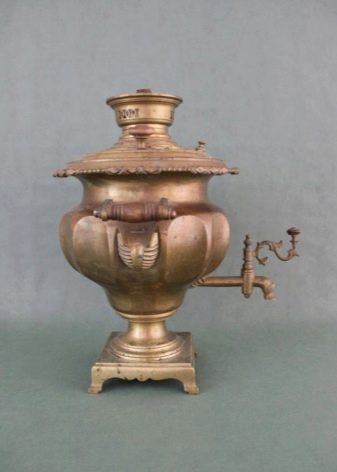
Products are of high value:
- over 100 years old;
- made in Tula;
- Polish models of the 17th-19th centuries;
- Teile brass samovars;
- Batashev models;
- made at Vorontsov factories;
- produced by the cartridge plant in the city of Tula.

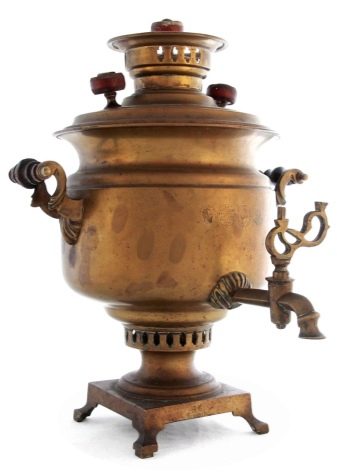
Turkish samovars are in high demand these days.
According to user reviews, they work smoothly for many years, look aesthetically pleasing and at the same time have an affordable price. This manufacturer offers a wide range of home, outdoor and outdoor products.

How to choose?
The cost of wood-burning samovars is quite high, therefore, when choosing, it is very important to focus on the following characteristics.
- Appearance. Make sure that there are no chips, cracks, scratches or dents on the surface of the product. Be sure to see how stable the samovar is on a horizontal surface. If it staggers or sways, there is a high risk that the device is damaged.
- Material. Estimate the material from which the vessel is made. If it is based on thin iron - such a product will quickly burn out, you can hardly enjoy such a samovar for a long time. If you want to buy a high quality wood-fired samovar, it is better to give preference to copper products. Such models do not rust and serve for a long time.
- Tightness. Make sure there are no problems with the faucet. If there are leaks, they will require additional repair work. Check that all non-tinned parts are arranged in such a way that water does not come into direct contact with metal, otherwise you can get poisoned.
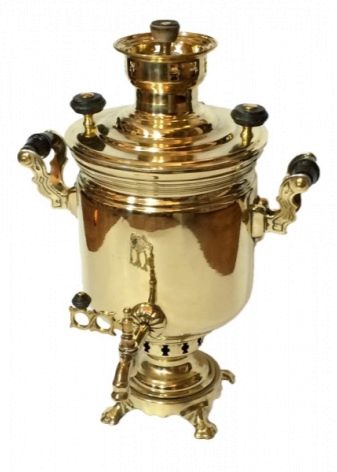

Samovars are produced in different volumes, the choice of the optimal model is made taking into account the number of users:
- for a family of 4-6 people, a small model of 3 liters is enough;
- for 6-8 people, it is better to give preference to 5-liter units;
- a company of 10-12 users will need a 7-liter device;
- if necessary, to drink at the same time from 30 to 50 people use buffet samovars designed for 40-50 liters.

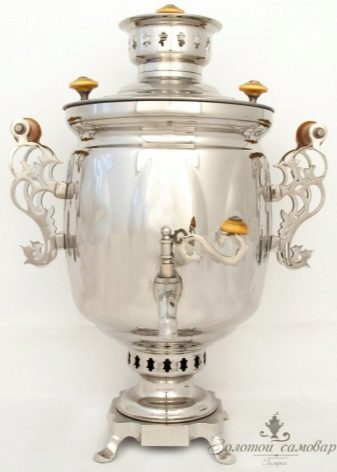
How to melt?
To light a samovar, different raw materials can be used as fuel.
- Smoldering coals from the barbecue - they can be shifted with metal tongs. In this case, the boiling time of water is significantly accelerated.
- Wood chips - it is best to use an apple tree, cherry, pear or poplar for kindling a samovar. These trees give the tea its characteristic aroma and taste.
- Cones - suitable for samovars, the volume of which does not exceed 2 liters. This material burns out very quickly, and if the capacity of the samovar is higher, then the cones simply will not have time to warm up the water before it boils.
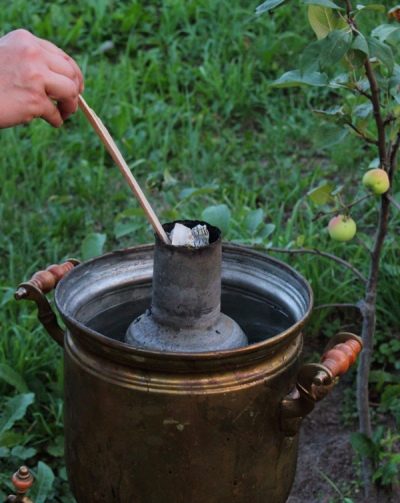
It is strictly forbidden to use lighter fluid or kerosene. During combustion, they will release toxic substances that lead to negative reactions in the body.
The sequence of actions for kindling a samovar is simple.
- Before lighting a samovar, you need to choose the right place for it. It should be placed on a metal tray, where hot coals and burnt fuel will be removed from the blower. The use of a wood-burning samovar in an enclosed space is allowed only if it is equipped with a ventilation system.
- Before starting kindling, pour water into the samovar. This must be done very carefully so that excess moisture does not accidentally get into the fire compartment. Otherwise, it will simply not be possible to drown it.
- Next, they lay firewood and set them on fire, as a rule, with the help of wood chips. In this case, the upper gate and the blower should be as open as possible - this will facilitate the flow of air and ensure good ignition.
- It is important to make sure that the tap through which the water comes out is firmly closed.
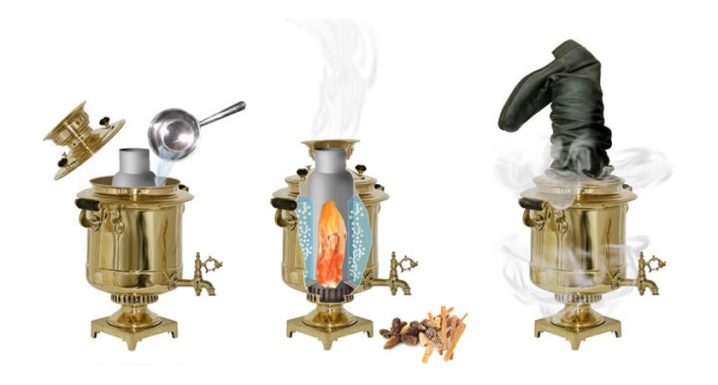
How to brew tea?
After the samovar boils, the heat compartment should be covered with a special cap.This reduces the flow of air and ensures that heat is retained inside the samovar itself. This creates the necessary conditions for brewing tea.
Next, you need to take a ceramic teapot, pour fragrant herbs, rose petals or medicinal fees into it, then pour water from a samovar and close it with a lid. In this case, it is advisable to use not boiling water, but hot water.
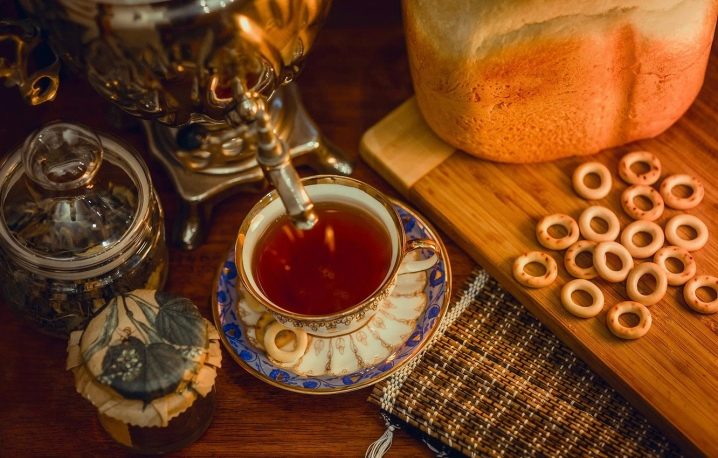
Usually the teapot is placed in the upper block, before that the cap is removed from the pipe. In the course of boiling water in the samovar, tea leaves are also infused. When everything is ready, you can pour the tea by mixing the tea leaves and water in the required proportions.
How to clean?
From time to time it becomes necessary to descale the samovar. To wash it, use folk remedies.
- Vinegar. The most common way is based on the use of a paste made up of vinegar, flour and salt. The flour and salt are mixed in equal amounts and the vinegar is carefully introduced in such a way that a medium-thick paste is obtained. This composition is used to wipe the product and rinse thoroughly with water.
- Lemon. Cut off a slice of lemon and carefully wipe the inside and outside of the appliance with it, brush and rinse if necessary. Lemon relieves the samovar well from green, coal deposits and traces of rust.
- It is best to clean brass samovars with a solution of oxalic acid or ammonia. To do this, the fabric is slightly moistened with a cleaning solution, wipe the surface and rinse with running water.
- Cleaning of small parts of a samovar is carried out by half an hour boiling in a solution of soda ash, it is made up at the rate of 1⁄2 tbsp. l. for 500 ml of water.
- Samovars made of stainless steel over time they become stained, fade and lose their characteristic shine. You can correct the situation with Goi paste or 9% vinegar.
- You can use Sprite or Coca-Cola to clean the inside of the surface. Sweet soda is poured into a samovar, left overnight, and in the morning cleaned with a soft brush and rinsed thoroughly.
- Potato peelings give a good effect. By the way, our ancient ancestors used this method. To remove scale, cleaning must be rinsed, poured into a samovar, filled with water, boiled for half an hour, and then left for a couple of hours.
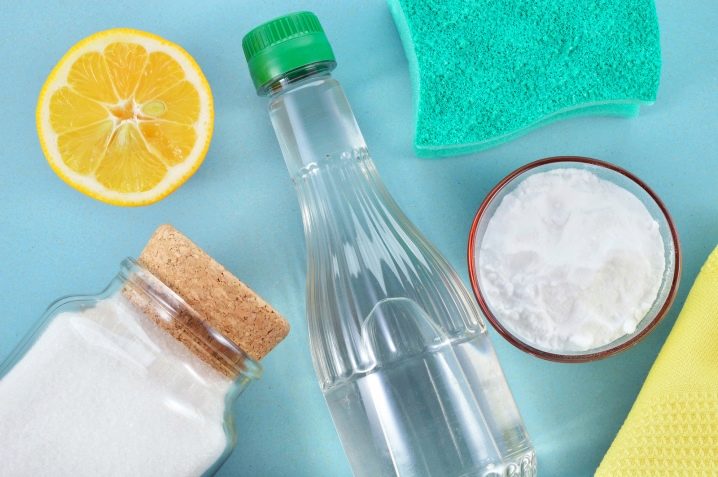
The keepers of traditional Russian cuisine are well aware that a drink prepared in a wood-fired samovar has an exquisite taste and sophisticated aroma. A hundred years ago, such utensils were ubiquitous. Nowadays, the samovar allows you to pay tribute to the primordially Russian traditions of tea drinking.
No other country in the world had such a respectful attitude to the samovar as in Russia, and no other piece of kitchen utensils contained only national flavor and spirituality.














The comment was sent successfully.